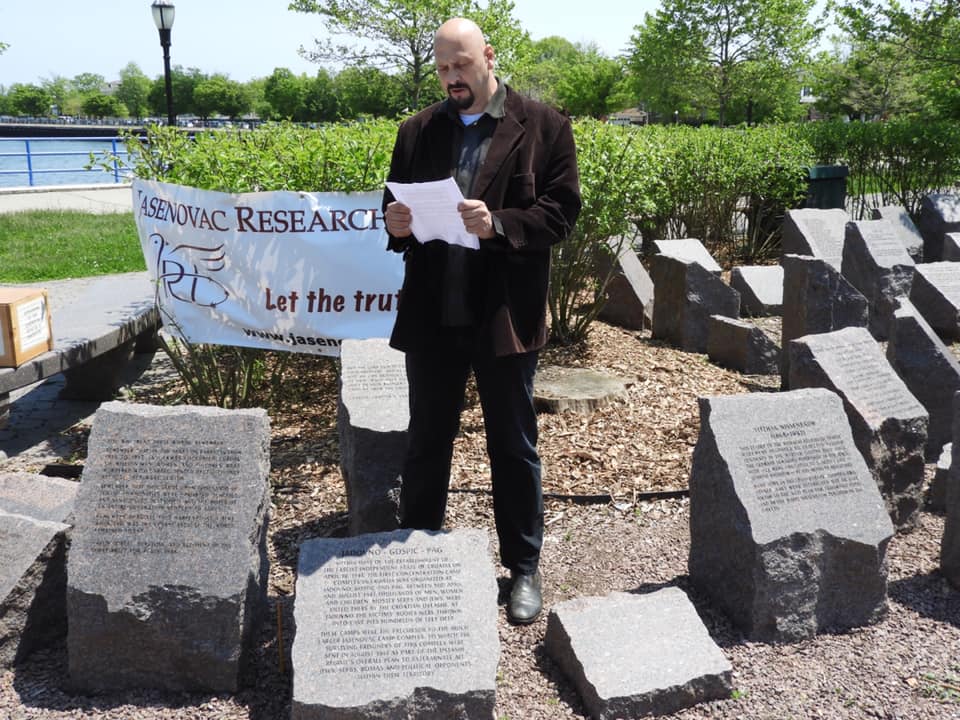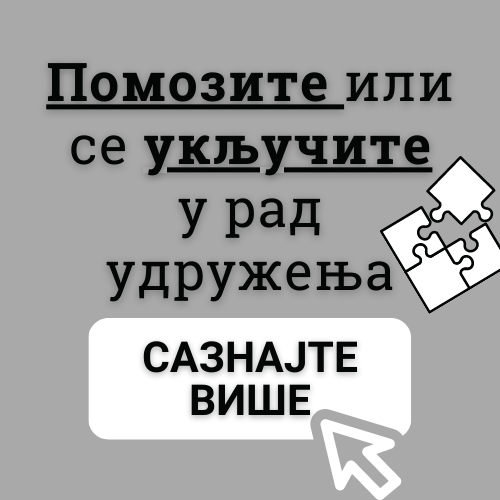Пошто сам се по ко зна који пут увјерио да васколико српство примјећује и поштује своје, тек када га уважавају туђини, свој говор у Њујорку нећу ни преводити.
I am here to greet you as a representative of the “Jadovno 1941.” organization from Banja Luka, Republic of Srpska. For over a decade, we have been fighting to remember and preserve knowledge of the first extermination camp of the Independent State of Croatia during WW2. What we are doing here today is a new and significant step to forward this goal, and I am very pleased and proud to be here with you.
No one spoke about this particular death camp until 2010, when we organized the first Remembrance Day. It had been completely forgotten.
To be honest, even I possessed no real knowledge about what happened from May to August 1941 in the area of Jadovno – Gospic – Pag. I just had a vague picture of Jadovno, wrongly derived from lectures in elementary school. The lectures I refer to were not even from history class, but rather, from languages and literature. Until I met the president of Jadovno 1941, Dusan Bastasic , in 2010, (and just to contextualize, I was born in 1977), I thought that Jadovno was an isolated incident. I thought it was merely a massacre committed by the Croatian “Ustasha” in some remote village. Then the poet Ivan Goran Kovacic heard about it. Shocked, he was inspired to write the poem Jama, which means“Pit“.
The truth was in fact, much more horrific, and for half a century, what was very well hidden from the public in the former Communist Yugoslavia was that death in Jadovno was no mere incident, or war crimes massacre. Death in Jadovno was in fact, a factory enterprise. In the triangle of Jadovno, in the mountain, Velebit, in the town, Gospic, the railroad station, and then the Aquatorium of the island Pag in Adriatic Sea, the Independent State of Croatia managed to kill, according to the investigation of historian Djuro Zatezalo, 40,000 men, women, children and elderly in just 132 days.
After a large-scale uprising of Serbians, solely because of the genocide that the Croatian “Ustasha” were committing against them, Fascist Italy was forced to intervene. In order not to jeopardize the war efforts on Eastern Front, Italians reoccupied land given to the ISC after the occupation of the Kingdom of Yugoslavia, and closed down Jadovno, the factory of death.
Even more horrific, is that about 2.000 prisoners who survived Jadovno, ended up being the first occupants of a larger and more infamous death camp – Jasenovac. So, we can say that the Jadovno death camp was the forefather of Jasenovac.
The Jadovno death camp is characteristic, in comparison to all other European death camps during the WW2, in that prisoners were killed by mallets, hammers, knifes, and thrown into the numerous cave pits in the mountain Velebit, or the depths of the Adriatic sea. Bones of victims are still there, at the bottom of pits. But pits are not graves! Those innocents deserve to be buried and mourned, and that truth about their suffering must see the light of the day. This must be known to the whole world.
And this is precisely what we fight for: truth, remembrance, and respect—that such atrocities never happen again.
Today, we can proudly say that our organization managed to insert the name “Jadovno” in the public discourse of the Republic of Srpska, Bosnia and Herzegovina, Serbia and Croatia. It was, henceforth, unknown. Jadovno 1941 organized and participated in numerous events, exhibitions, lectures, and scientific studies about this death camp in numerous countries in Europe and world.
This road led has led us to the United States of America. In 2013 we had an exhibition and lecture in New York, in the now burned St. Sava Cathedral. There we met Barry Lituchy and Dany Novak, and made the commitment that one stone in this park should carry the name and therefore remember the victims of Jadovno.
This day is very important for the organization Jadovno 1941, and for me personally, for one more reason—we managed to initiate the rebuilding of the monument to the victims built during the communist rule in Yugoslavia, and it is still standing there, near the most infamous pit, Sharanova.
But on the Island of Pag, we restored through the funds of the Jadovno 1941 the memorial stone, which memorializes 8.000 Serbs and Jews and Roma, killed and tossed in the sea. We restored it once, twice, and even a third time—because each time, the memorial was destroyed. No one was arrested, and no additional effort has been made by the Croatian government to ensure that vandalism of the present day followers of Croatian Ustasha ideology never happen again.
This racist ideology is still there, however, the commemorative plate is not. To illustrate how things are now, I will just mention that the Croatian president Kolinda Grabar Kitarovic, on May 9th this year, when whole World was celebrating the victory against Nazism, went to Bleiburg in Austria, to pay her respects to the Ustasha killed by the Partizan units at the end of WW2.
So, for us who are working on the remembrance of Jadovno on this land, in present day Croatia, this is a very, very important event. We hope that in land of the free, and home of the brave, this memorial stone will be safe from destruction; that it will remain, and on the North American continent preserve the knowledge about the death camp “Jadovno”, where Jews and Serbs were killed just because they have been what they are.
In Croatia, we still wait for approval to build the Serbian Orthodox chapel „Jadovno“ on the site, Sharanova Jama. Yes, we wait, and Lord knows how long we will wait. But we do not sit and cry. Every year we carry simple wooden crosses, and we mark pits, and other places of suffering in the area of Jadovno death camp.
I hope that this memorial stone will be one of the building blocks toward a more protective wall against the historic revisionism, and the denying of the holocaust and genocide against Serbs. It is also the building block between the brother nations—Jews and Serbs, once proclaimed by the regime of the Independent State of Croatia, and further Ante Pavelic, as subhumans.
We owe a great respect and gratitude toward our Jewish brothers, namely Barry Lituchy and Dany Novak. Without you, this inscription on the stone, and even my presence here, would be impossible. But, we must ask for some more help.
After the fall of communism in the Former Socialist Federal Republic of Yugoslavia where the regime hid the truth, Serbs are looking to the Jews to learn how to preserve remembrance about genocide against us. Today everybody in the world is aware of the suffering of the Jews during WW2, but virtually no one in the world knows about the genocide against Serbs. We have lot to learn, and lot to ask.
For example, Jews have special term for genocide in WW2. The term “holocaust” is an internationally recognized term, and in Shoa in ivrit, or in the Hebrew language a recognized term. Serbs have no such word, and Jadovno 41 started an initiative to name one word, for all our suffering. We proposed the word Pokolj, which in Serbian means slaughter. For this initiative, we have found unanticipated opposition. We expect a lot of public hearings and conferences and for this reason, we will need your advice, and experience to help us in this new battle for truth and remembrance.
So, with the utmost satisfaction and pride, I thank you all for being here, and I promise that on June 15 this year, the organization Jadovno 1941 and I, personally, will be on the camp site, and we will mark for the 10th annual Jadovno remembrance day–despite all odds.
And in the end I am left to conclude this speech in my native language, pronouncing the sentence:
НЕКА СЕ ПОКОЉ НИКАДА НЕ ПОНОВИ!
MAY THE SLAUGHTER NEVER HAPPEN AGAIN!
Danijel Simić
Извор/Source:



